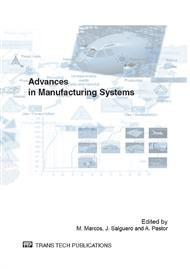[1]
N. Boysen et al: Euro. J. of Oper. Res. Vol. 183 (2007), pp.674-693.
Google Scholar
[2]
A. Scholl and C. Becker: Euro. J. of Oper. Res. Vol. 168 (2006), pp.666-693.
Google Scholar
[3]
G. Heike et al: Int. J. of Prod. Econ. Vol. 72 (2001), pp.103-120.
Google Scholar
[4]
F. Mas, J. Ríos, J. L. Menéndez, J. C. Hernández and A. Vizán, in: Concurrent conceptual design of aero-structure assembly lines, Proc. ICE 2008, Lisbon (PORTUGAL), (2008).
Google Scholar
[5]
J. L. Menéndez, F. Mas, J. Servan and J. Ríos, in: Virtual verification of the Airbus A400M FAL industrialization, Proc. MESIC 2011, Cádiz (SPAIN), (2011).
Google Scholar
[6]
J. Servan, F. Mas, J. L. Menéndez and J. Ríos, in: Using augmented reality in Airbus A400M shopfloor assembly work instructions, Proc. MESIC 2011, Cádiz (SPAIN), (2011).
DOI: 10.1063/1.4707618
Google Scholar
[7]
F. Mas, J. Ríos and J. L. Menéndez, in: Scenario for Concurrent Conceptual Assembly Line Design: a case study, Proc. MESIC 2011, Cádiz (SPAIN), (2011).
Google Scholar
[8]
A. Scholl and C. Becker: Euro. J. of Oper. Res. Vol. 168 (2006), pp.666-693.
Google Scholar
[9]
A. Scholl: Balancing and sequencing of assembly lines (Physica Verlag, Heidelberg 1999).
Google Scholar
[10]
R. V. Johnson: Manag. Sci. Vol. 34 (1988), pp.240-253.
Google Scholar
[11]
T. R. Hoffmann: Manag. Sci. Vol. 38 (1992), pp.39-47.
Google Scholar
[12]
A. Scholl and R. Klein: J. on Comp. Vol. 9 (1997), pp.319-334.
Google Scholar
[13]
W. B. Helgeson and D. P. Birnie: J. Ind. Eng. Vol. 12 (1961), p.394–398.
Google Scholar
[14]
S. Emde, N. Boysen and A. Scholl: Balancing mixed-model assembly lines: a computational evaluation of objectives to smoothen workload, Jena Research Paper, (2008).
DOI: 10.1080/00207540902810577
Google Scholar
[15]
F. Mas, J. Ríos, J. L. Menéndez, J. C. Hernández and A. Vizán, in: Information Model for Assembly Line Design at Conceptual Phase, Proc. MESIC 2009, Alcoy (SPAIN), (2009).
Google Scholar


